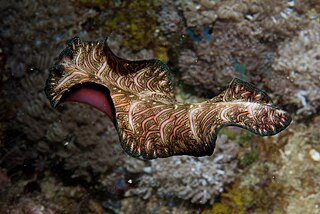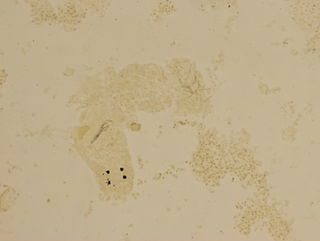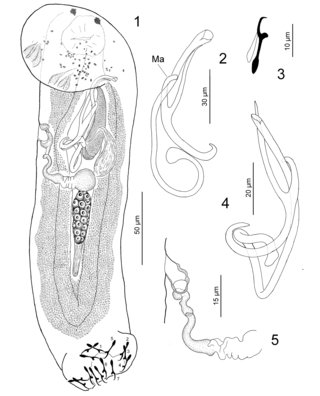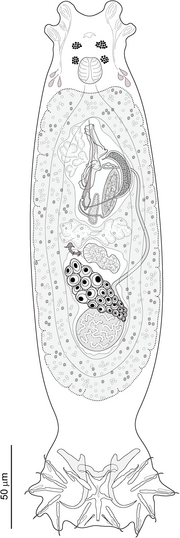
The flatworms, flat worms, Platyhelminthes, or platyhelminths are a phylum of relatively simple bilaterian, unsegmented, soft-bodied invertebrates. Unlike other bilaterians, they are acoelomates, and have no specialised circulatory and respiratory organs, which restricts them to having flattened shapes that allow oxygen and nutrients to pass through their bodies by diffusion. The digestive cavity has only one opening for both ingestion and egestion ; as a result, the food cannot be processed continuously.

The tinfoil barb is a tropical Southeast Asian freshwater fish of the family Cyprinidae. This species was originally described as Barbus schwanenfeldii by Pieter Bleeker in 1853, and has also been placed in the genera Barbodes and Puntius. The specific epithet is frequently misspelled schwanefeldii.

Monogeneans, members of the class Monogenea, are a group of ectoparasitic flatworms commonly found on the skin, gills, or fins of fish. They have a direct lifecycle and do not require an intermediate host. Adults are hermaphrodites, meaning they have both male and female reproductive structures.

The stone moroko, also known as the topmouth gudgeon, is a fish belonging to the Cyprinid family, native to Asia, but introduced and now considered an invasive species in Europe and North America. The fish's size is rarely above 8 cm and usually 2 to 7.5 cm long.

Dactylogyrus vastator is a species of hermaphroditic flatworms of class Monogenea. It is an ectoparasite of fish which infests the gills. It is problematic on fish farms. It is otherwise non-hazardous to humans.
Megalodiscus temperatus is a Digenean in the phylum Platyhelminthes. This parasite belongs to the Cladorchiidae family and is a common parasite located in the urinary bladder and rectum of frogs. The primary host is frogs and the intermediate hosts of Megalodiscus temeperatus are freshwater snails in the genus Helisoma.
Dactylogyridae is a family of monogenean flatworms.

Cichlidogyrus is a genus of monopisthocotylean monogeneans in the family Ancyrocephalidae. The type-species of the genus is Cichlidogyrus arthracanthusPaperna, 1960, by original designation. All the species of the genus are parasites on the gills of fish, namely African Cichlidae, Nandidae and Cyprinodontidae.

Pseudorhabdosynochus is a genus of monopisthocotylean monogeneans, included in the family Diplectanidae. The type-species of the genus is Pseudorhabdosynochus epinepheli .

The Diplectanidae are a family of monopisthocotylean monogeneans. They are all parasitic on the gills of fish. Diplectanids are small animals, generally around 1 mm in length. As parasites, they can be extremely numerous, up to several thousand on an individual fish.
Alexandr Vladimirovich Gussev, sometimes spelled Gusev in the literature, was a Russian helminthologist specialist of monogeneans.
Gyrodactylus turnbulli is an ectoparasite from the class Monogenea, is part of the phylum Platyhelminthes, and from the genus Gyrodactylus. It only requires one host to transmit an infection; however, since this parasite lacks oncomiracidium, it must rely on either the adult or subadult for spread of infection. Found in freshwater, this flatworm is commonly found on the gills and fins of the guppy, Poecilia reticulata. G. turnbulli was said to be host specific, but an experiment where parasitologists artificially infected guppies suggests that the parasite can infect a wider range of species. This ability is achievable by host switching, which promotes speciation.
Gyrodactylus leptorhynchi is a small monogenean obligate ectoparasite which parasitizes freshwater bay pipefish. Gyrodactylus leptorhynchi is the seventh Gyrodactylus species known to infect bay pipefish and the first characterized along the Pacific coast of North America. The parasite can get into captive fish environments, such as fish farms and aquariums, where it may spread in as little as 10 days. Gyrodactylus species are known to centralize on the brood pouch in male fish, this may allow for transmission to newly hatched young. However, in Gyrodactylus leptorhynchi the parasite was found mostly found attached to body surfaces such as the dorsal fins.

Ancyrocephalidae is a family of monogenean flatworms. The family is considered as a "temporary name" in WorMS but includes a large number of genera and species.
Delane C. Kritsky is an American parasitologist who specialised on the Monogenea, a class of parasitic flatworms which are important ectoparasites of fishes. His research was mainly in the fields of taxonomy, faunistics, and phylogeny of the Monogenea.

Cichlidogyrus jeanloujustinei is a species of monopisthocotylean monogenean in the family Ancyrocephalidae. It is a parasite of the gills of the fish Eretmodus marksmithi in Lake Tanganyika, Burundi.

Cichlidogyrus evikae is a species of monopisthocotylean monogenean in the family Ancyrocephalidae. It is a parasite of the gills of the fish Tanganicodus irsacae in Lake Tanganyika, Burundi.

Paracolpenteron hubbsii is a species of dactylogyrid Monogenean. It is the single species of the genus Paracolpenteron. It is a parasite of the urinary bladder of the maya needlefish Strongylura hubbsi (Belonidae).

Cichlidogyrus kmentovae is a species of monopisthocotylean monogenean in the family Ancyrocephalidae. It is a parasite of the gills of the fish Hemichromis stellifer of the lower Basin of River Congo.

Sparicotyle chrysophrii is a species of monogenean, parasitic on the gills of the marine fish. It belongs to the family Microcotylidae. Its type-host is the gilt-head seabream.














